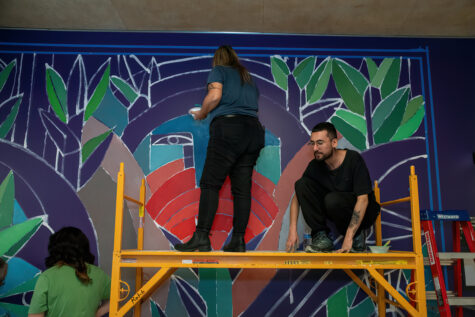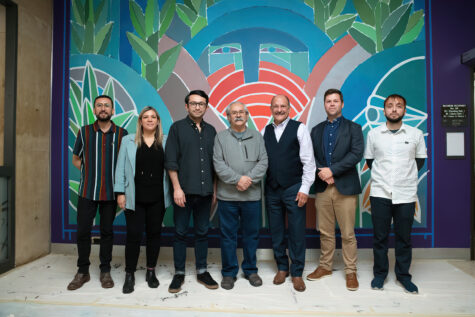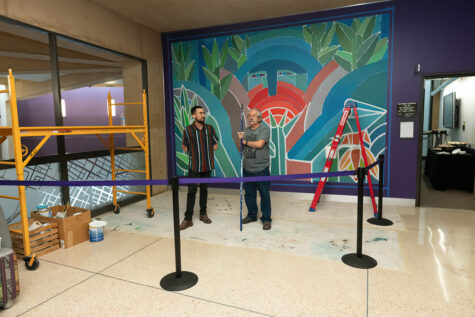Photo by William Lamm
On the morning of Wednesday Sept. 27, a couple paint cans and a tarp were laid out in front of a blank, purple wall on the second floor of Sykes Student Union. By Thursday afternoon, the purple wall had become adorned with streaks of green, blue and red hues.
Passersby in Sykes will now see a vibrant, encompassing mural on the wall located near the Center for Student Involvement and the Prayer Room. With blocks of solid color and curved, white lines, parts of the mural resemble leafy plant stems. Others resemble geometric faces.
But to Alejandro “Mono” González — who spoke through a translator — “it’s an open space for interpretation.”

West Chester University hosted Mono, a renowned Chilean artist, as an artist-in-residency the entire week of Sept. 25. “Mono & Mural,” a program directed by Dr. Daniela Johannes, Associate Professor of Language and Latinx Studies, and David Jones, Associate Professor of the Art and Design Department, welcomed Mono to campus to perform a one-of-a-kind mural in Sykes described as a “local cultural heritage and a homage to Latinx cultures” in a flier for the event.
He also served as the keynote speaker for WCU’s 15th Annual Latinx Communities Conference. Usually, the conference takes the form of a panel of community leaders, academics and others who present work that they’ve done on topics relating to the Latinx community. This year, the conference’s organizers decided to take a new approach to celebrate the event’s 15th year.

“I thought, why don’t we bring a renowned muralist to make something beautiful, and that’s commemorative of the conference and celebrates Latinx identities,” Johannes said. “When we see [the mural], we feel like we belong here.”
Throughout the week of his residency, Mono also gave an artist lecture for the WCU community at an exhibit currently on show in the John H. Baker Gallery in The E.O. Bull Center. Open since Aug. 29, the exhibit features various pieces of art in other artistic mediums made by Mono and his son, Sebastián. Mono’s work will remain on campus until Oct. 13. Some WCU art students also had the opportunity to attend a printmaking masterclass hosted by the muralist.
Johannes, originally from Chile, has long admired Mono’s artwork, particularly the way he has enabled social commentary through his murals.
“He has created such an identity for not only Chile, but Latin America,” Johannes said. “People recognize his work, his iconography is very unique and particular to him.”

Mono has traveled across the world painting murals: Argentina, Italy, China, Cuba, to name a few. But after 76 years of his life, his roots remain in Chile. Mono says he traces his artistic inspiration back to experiences in his home country. Having lived during the 1973 Chilean coup d’etat, life in Chile during a period of such unrest was formative in teaching him about the social and political impact of art. He began his career as a street artist, using his skills to create political images.
Over time, Mono has come to view public art as essential to leaving a mark on history and providing a testimony to lived experiences and existence. This year marks the 50th year since the Chilean coup, making the mural at WCU and Mono’s work even more significant.
“The commemoration is about honoring the losses, and the disappeared, and [it is] also a commitment to democracy in the future,” Johannes said of the mural.
Mono has also worked with youth and collectives at various points throughout his career. According to the event flier, during the 1960s, Mono created an artist collective and educational group named “La Brigada Ramona Parra” for young people to take part in activism through street art around Santiago de Chile.
Since then, Mono says using art as a medium for commentary remains an integral part of his work, and he stays extremely active as an artist. In fact, his energy is exactly how his nickname came to be — in Spanish, “Mono” means “Monkey”.

“I’m 76 and I’m restless,” Mono said. “It’s about how quick I work… When I work every day, I keep learning and keep getting motivated. So, this state of being restless [is] like monkeys, that move from one wave to another.”
Despite his youthfulness, Mono acknowledges the importance of passing on what he’s learned to new generations as he gets older, in hopes that the tradition of leaving marks on history through art is continued.
“It’s like doing a baton pass,” Mono said.
All in all, the mural took two days for Mono and his assistants to finish. Throughout the process, various classes had the opportunity to come to the Sykes location to watch Mono paint the mural and ask him questions about his process.
Johannes hopes that the Sykes mural serves as an opportunity to learn more about Latin America’s history and the socio-political impact of art. She also views it as an important contribution to bettering inclusivity in higher education and hopes the Latinx population in West Chester derive a sense of belonging from it.
“I hope that the students learn about the impact of art and how art can be an agent of change,” Johannes said. “And how we can do that here [at WCU] too. I hope that people get motivated.”
Olivia Schlinkman is a third-year Political Science major with minors in Journalism and Spanish. os969352@wcupa.edu.

